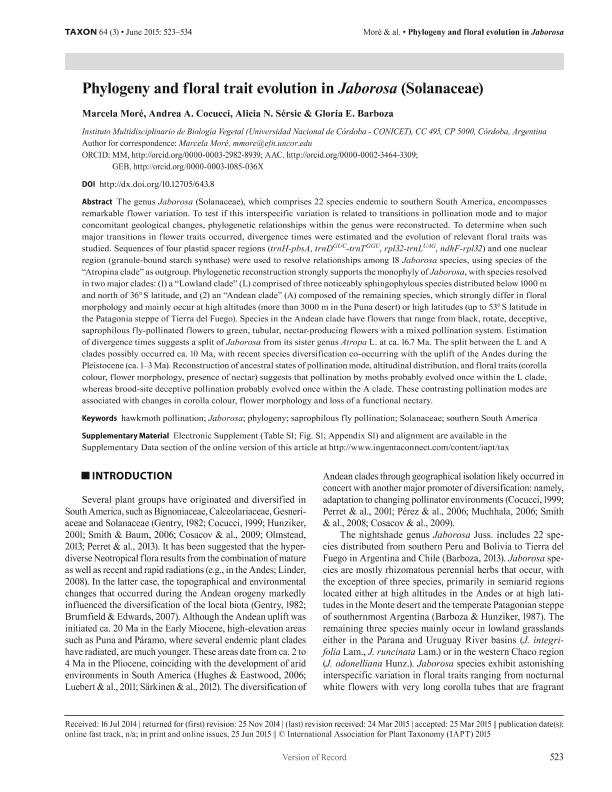Mostrar el registro sencillo del ítem
dc.contributor.author
More, Marcela

dc.contributor.author
Cocucci, Andrea Aristides

dc.contributor.author
Sersic, Alicia Noemi

dc.contributor.author
Barboza, Gloria Estela

dc.date.available
2017-01-31T18:55:39Z
dc.date.issued
2015-06
dc.identifier.citation
More, Marcela; Cocucci, Andrea Aristides; Sersic, Alicia Noemi; Barboza, Gloria Estela; Phylogeny and floral trait evolution in Jaborosa (Solanaceae); International Association for Plant Taxonomy; Taxon; 64; 3; 6-2015; 523-534
dc.identifier.issn
0040-0262
dc.identifier.uri
http://hdl.handle.net/11336/12249
dc.description.abstract
The genus Jaborosa (Solanaceae), which comprises 22 species endemic to southern South America, encompasses remarkable flower variation. To test if this interspecific variation is related to transitions in pollination mode and to major concomitant geological changes, phylogenetic relationships within the genus were reconstructed. To determine when such major transitions in flower traits occurred, divergence times were estimated and the evolution of relevant floral traits was studied. Sequences of four plastid spacer regions (trnH-pbsA, trnDGUC -trnTGGU , rpl32-trnLUAG , ndhF-rpl32) and one nuclear region (granule-bound starch synthase) were used to resolve relationships among 18 Jaborosa species, using species of the “Atropina clade” as outgroup. Phylogenetic reconstruction strongly supports the monophyly of Jaborosa, with species resolved in two major clades: (1) a “Lowland clade” (L) comprised of three noticeably sphingophylous species distributed below 1000 m and north of 36° S latitude, and (2) an “Andean clade” (A) composed of the remaining species, which strongly differ in floral morphology and mainly occur at high altitudes (more than 3000 m in the Puna desert) or high latitudes (up to 53° S latitude in the Patagonia steppe of Tierra del Fuego). Species in the Andean clade have flowers that range from black, rotate, deceptive, saprophilous fly-pollinated flowers to green, tubular, nectar-producing flowers with a mixed pollination system. Estimation of divergence times suggests a split of Jaborosa from its sister genus Atropa L. at ca. 16.7 Ma. The split between the L and A clades possibly occurred ca. 10 Ma, with recent species diversification co-occurring with the uplift of the Andes during the Pleistocene (ca. 1–3 Ma). Reconstruction of ancestral states of pollination mode, altitudinal distribution, and floral traits (corolla colour, flower morphology, presence of nectar) suggests that pollination by moths probably evolved once within the L clade, whereas brood-site deceptive pollination probably evolved once within the A clade. These contrasting pollination modes are associated with changes in corolla colour, flower morphology and loss of a functional nectary.
dc.format
application/pdf
dc.language.iso
eng
dc.publisher
International Association for Plant Taxonomy

dc.rights
info:eu-repo/semantics/openAccess
dc.rights.uri
https://creativecommons.org/licenses/by-nc-sa/2.5/ar/
dc.subject
Hawkmoth Pollination
dc.subject
Jaborosa
dc.subject
Phylogeny
dc.subject
Saprophilous Fly Pollination
dc.subject.classification
Ciencias de las Plantas, Botánica

dc.subject.classification
Ciencias Biológicas

dc.subject.classification
CIENCIAS NATURALES Y EXACTAS

dc.title
Phylogeny and floral trait evolution in Jaborosa (Solanaceae)
dc.type
info:eu-repo/semantics/article
dc.type
info:ar-repo/semantics/artículo
dc.type
info:eu-repo/semantics/publishedVersion
dc.date.updated
2017-01-31T15:37:04Z
dc.identifier.eissn
1996-8175
dc.journal.volume
64
dc.journal.number
3
dc.journal.pagination
523-534
dc.journal.pais
Austria

dc.journal.ciudad
Viena
dc.description.fil
Fil: More, Marcela. Consejo Nacional de Investigaciones Científicas y Técnicas. Centro Científico Tecnológico Córdoba. Instituto Multidisciplinario de Biología Vegetal (p); Argentina
dc.description.fil
Fil: Cocucci, Andrea Aristides. Consejo Nacional de Investigaciones Científicas y Técnicas. Centro Científico Tecnológico Córdoba. Instituto Multidisciplinario de Biología Vegetal (p); Argentina
dc.description.fil
Fil: Sersic, Alicia Noemi. Consejo Nacional de Investigaciones Científicas y Técnicas. Centro Científico Tecnológico Córdoba. Instituto Multidisciplinario de Biología Vegetal (p); Argentina
dc.description.fil
Fil: Barboza, Gloria Estela. Consejo Nacional de Investigaciones Científicas y Técnicas. Centro Científico Tecnológico Córdoba. Instituto Multidisciplinario de Biología Vegetal (p); Argentina
dc.journal.title
Taxon

dc.relation.alternativeid
info:eu-repo/semantics/altIdentifier/doi/http://dx.doi.org/10.12705/643.8
Archivos asociados
